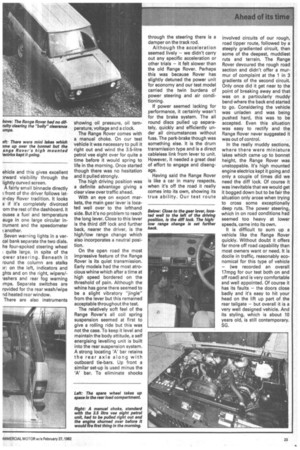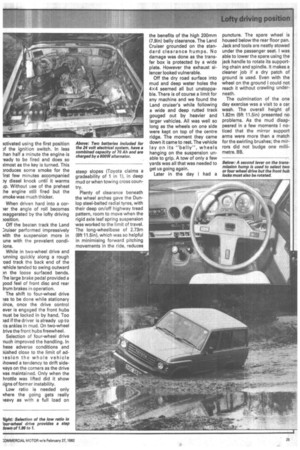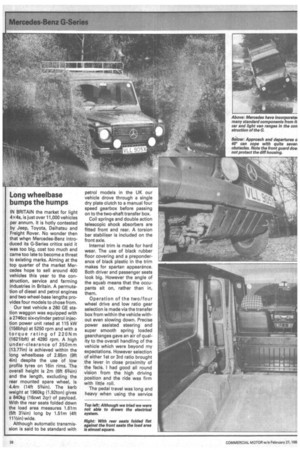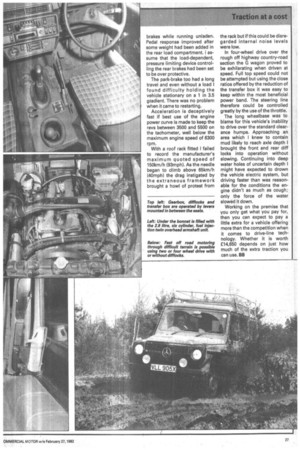4x4s: tough tests for three main maket
Page 18

Page 19

Page 20

Page 21

Page 22

Page 23

If you've noticed an error in this article please click here to report it so we can fix it.
THREE DAYS' hard driving over rough roads, cross-country and alpine circuits tested three 4x4 machines. Steve Gray and Bill Brock were the drivers, and Brian Weatherley took the pictures.
The demand for "goanywhere" vehicles has been steadily increasing for the past ten years. At first it was farmers and the military who needed the capacity to turn off the metalled highway onto a rutted track or muddy field without coming to grief. Now a multitude of other potential users have discovered just what a difference this ability could make to them.
At the same time there has been a trend toward more comfortable and even luxuriously equipped 4x4s at the lighter end of the market. Even the long-serving but spartan Land-Rover has been progressively improved and uprated in an attempt to broaden its appeal.
But the biggest growth area has been in vehicles which offer saloon car looks for main road and urban use, but can take on the worst terrain without a qualm.
The idea — perhaps not surprisingly — emanated from North America where there is a tremendous market among sportsmen for these vehicles.
Here, in Britain, and indeed Europe, few apart from the very rich could afford to buy, or for that matter run, a huge American machine.
It was Land-Rover's Range Rover which started the ball rolling and the concept has been copied, with more or less success and accuracy, by other European and Japanese makers.
At the monent there are three main competitors on sale in Britain from these areas: The Toyota Land Cruiser, Mercedes G-wagon and Leyland's long established, but refined, Range Rover. We have put all three through their paces, both on the public roads and at a rough terrain proving ground, part of which we use for our tipper tests.
This vehicle is at home anywhere
THE sales brochure for the Range Rover boldly claims: "You can, quite simply, go anywhere in a Range Rover." A startling claim for any vehicle, and especially one that costs £14,996 and has all the creature comforts of an executive saloon car. What it really means is that the Range Rover is equally at home cruising in London's West End or mud plugging on a construction site churned up by earthmovers.
Unfortunately — or was it fortunately — it acquired a reputation in the early days as being more often than not used for the former. It became a cult vehicle — something like the Minimoke in the Sixties — with the affluent waiting months, or paying well over the retail price, to buy it as a second car. It probably never went further than the local shops.
Things have changed and the Range Rover is looked upon more these days as a workhorse. Those who still buy them to "pose" really don't know what they're missing.
When we first tested the Range Rover some years ago, it was available only in two-door form, with rather cheap-looking, somewhat "plasticky" seats. Things have changed. True there's an economy version, the Fleetline, which retains plastic — vinyl — seating, manual steering, and a lower standard of trim.
Last week our test vehicle was the four-door, top model, fitted with air conditioning. The addition of the extra two doors has been accomplished painlessly. Neither the front nor rear doors look out of place or too small — nor indeed are they — and the wheelbase has been kept the same at 2.54m (100in). However, to accommodate the extra doors, the rear seat has been moved back reducing the seatup load area by 0.1 5cum (5.3cuft) to 1.02cum (36.18cuft). This doesn't affect the seat down capacity which stays at 2cum (70.8cuft). There's also a weight penalty of 32kg (691b). However, towing capacit remain the same with a rm mum four-wheel power bral trailer limit of 4 tonnes (8,8161 When I first climbed into ' Range Rover — and it is quit step up — I had an impressior space and comfort. The seat position is high within t ehicle and this gives excellent )rward visibility through the lightly curved screen.
A fairly small binnacle directly front of the driver follows latK-day Rover tradition. It looks s if it's completely divorced om the rest of the dashboard. It ouses a fuel and temperature auge in one large circular intrument and the speedometer another.
Seven warning lights in a vercal bank separate the two dials. he four-spoked steering wheel quite large, in spite of the ower steering. Beneath it round the column are stalks )r: on the left, indicators and ghts and on the right, wipers/lashers and rear fog warning imps. Separate switches are rovided for the rear wash/wipe rid heated rear window.
There are also instruments showing oil pressure, oil temperature, voltage and a clock.
The Range Rover comes with a manual choke. On our test vehicle it was necessary to pull it right out and wind the 3.5-litre petrol vee eight over for quite a time before it would spring to life in the morning. Once started though there was no hesitation and it pulled strongly.
The high driving position was a definite advantage giving a clear view over traffic ahead.
With an eye on export markets, the main gear lever is located well over to the lefthand side. But it's no problem to reach the long lever. Close to this lever is the third diff lock and further back, nearer the driver, is the high/low range change which also incorporates a neutral position.
On the open road the most impressive feature of the Range Rover is its quiet transmission, Early models had the most atrocious whine which after a time at high speed bordered on the threshold of pain. Although the whine has gone there seemed to be a slight vibratory "jingle" from the lever but this remained acceptable throughout the test.
The relatively soft feel of the Range Rover's all coil spring suspension seemed at first to give a rolling ride but this was not the case. To keep it level and maintain the body attitude, a self energising levelling unit is built into the rear suspension system. A strong locating 'A' bar retains the rear axle along with outboard tie-bars. Up front a similar set-up is used minus the 'A' bar. To eliminate shocks through the steering there is a damper on the track rod.
Although the acceleration seemed lively — we didn't carry out any specific acceleration or other trials — it felt slower than the old Range Rover. Perhaps this was because Rover has slightly detuned the power unit for economy and our test model carried the twin burdens of power steering and air conditioning.
If power seemed lacking for performance, it certainly wasn't for the brake system. The all round discs pulled up separately, quickly and efficiently under all circumstances without fuss. The park-brake though was something else. It is the drum transmission type and is a direct cableless link from lever to unit. However, it needed a great deal of effort to engage and disengage.
Having said the Range Rover is like a car in many respects, when it's off the road it really comes into its own, showing its true ability. Our test route involved circuits of our rough, road tipper route, followed by a steeply gradiented circuit, then some of the deepest, muddiest ruts and terrain. The Range Rover devoured the rough road section and didn't offer a murmur of complaint at the 1 in 3 gradients of the second circuit. Only once did it get near to the point of breaking away and that was on a particularly muddy bend where the back end started to go. Considering the vehicle was unladen and was being pushed hard, this was to be accepted. Even this situation was easy to rectify and the Range Rover never suggested it was out of control.
In the really muddy sections, where there were miniature lakes which came up to bonnet height, the Range Rover was unstoppable. It's high mounted engine electrics kept it going and only a couple of times did we need the diff lock. Of course it was inevitable that we would get it bogged down but to be fair the situation only arose when trying to cross some exceptionally deep ruts. The power steering, which in on road conditions had seemed too heavy at lower speeds, came into its own.
It is difficult to sum up a vehicle like the Range Rover quickly. Without doubt it offers far more off road capability than most owners want or need. It is docile in traffic, reasonably economical for this type of vehicle — (we recorded an overall 17mpg for our test both on and off road) and is very comfortable and well appointed. Of course it has its faults — the doors close badly and it's easy to hit your head on the lift up part of the rear tailgate — but overall it is a very well designed vehicle. And its styling, which is about 10 years old, is still contemporary. SG.
Far cry from first utility model
THE MK II Land Cruiser is a far cry from the utility 4 X 4 vehicle introduced by Toyota in the mid 70's. The new long-wheelbase four-door estate, announced last July, now priced at £11,193, is set to compete in the traditional market place so long dominated by the Land-Rover and Range Rover.
In Britain only the 3980cc (242.9cuin) diesel engined model is available. It is rated at 70kW (103bhp) and gives a maximum torque of 240Nm (177Ibft).
This low revving engine proved to be very economical when used on the mixed motorway and town traffic section of our test. It returned 24 miles per gallon of derv. The needle on the gauge showing the level of the 19.8 gallon tank barely moved at all.
Large 16in wheels and ground clearance of 200mm (7.9in) contribute to the high seating position from which the occupants can see above the roofs of the surrounding traffic. Both driver and passenger seats are large, comfortable and provide plenty of back support. The rear bench seat folds down flat to lengthen the 1.52m (5ft) wide load area from 1.01m (40in) to 1.78m (70in). With a kerb weight of just under 2 tons a maximum load of 300kg (660Ib) can be accommodated in addition to driver and passenger.
The tail gate, divides into an upper and lower section, and gives clear access to the rear load compartment where the platform height is set at 0.76m (30in) above the ground unladen. Internal trim combines the practical with the aesthetic. There are carpets throughot cloth seats and a mixture cloth and plastic on the door The floor is flush with the dol sills. This is most desirable any vehicle which has an c road capability. It makes it co venient to sweep out any acc mulation of debris.
Instrumentation includes pressure gauge, voltmete speedometer and tachomet, The remainder of the facia taken up with the radio, heath! and ventilation system and glove box. Extra stowage is pr vided in a large consol box b tween the seats and there is door pouch.
Vertical adjustment of tl steering column is an asset. TI steering wheel carries stalk co trols for lights, direction Indic tors, intermittent two-sper wipers and wash. Pressure 1 the horn button, located on three of the steering whE spokes, resulted too often in u expected blasts at the mc inopportune moments.
Gear-change lever, two/to wheel-drive and low rat selector are mounted with easy reach on top of the trar mission hump. The hand bra is located further back betwe the seats.
Long semi-elliptical le springs give a firm ride unc normal road conditions wh light power steering, with minimal self centring actic demand manual effort when rr noeuvring.
Cold starts are helped by t cylinder preheat system which activated using the first position 3f the ignition switch. In less :han half a minute the engine is • eady to be fired and does so almost as the key is turned. This produces some smoke for the irst few minutes accompanied 3y diesel knock until it warms 43. Without use of the preheat :he engine still fired but the smoke was much thicker.
When driven hard into a corer the angle of roll becomes sxaggerated by the lofty driving )osition.
Off the beaten track the Land :ruiser performed impressively with the suspension more in tine with the prevalent condiions.
While in two-wheel drive and .unning quickly along a rough .oad track the back end of the rehicle tended to swing outward mi the loose surfaced bends. rhe large brake pedal provided a )ood feel of front disc and rear irum brakes in operation.
The shift to four-wheel drive as to be done while stationary since, once the drive control ever is engaged the front hubs nust be locked in by hand. Too md if the driver is already up to us ankles in mud. On two-wheel irive the front hubs freewheel. Selection of four-wheel drive nuch improved the handling. In hese adverse conditions and Aished close to the limit of adlesion the whole vehicle ihowed a tendency to drift sideways on the corners as the drive was maintained. Only when the hrottle was lifted did it show lig ns of former instability.
Low ratio is needed only where the going gets really teavy as with a full load on steep slopes (Toyota claims a gradeability of 1 in 1), in deep mud or when towing cross country.
Plenty of clearance beneath the wheel arches gave the Dunlop steel-belted radial tyres, with their deep on/off highway tread pattern, room to move when the rigid axle leaf spring suspension was worked to the limit of travel. The long-wheelbase of 2.73m (8ft 11.5in), which was so helpful in minimising forward pitching movements in the ride, reduces
the benefits of the high 200mm (7.9in) belly clearance. The Land Cruiser grounded on the standard clearance humps. No damage was done as the transfer box is protected by a wide plate. However the exhaust silencer looked vulnerable.
Off the dry road surface into mud and deep water holes the 4x4 seemed all but unstoppable. There is of course a limit for any machine and we found the Land cruiser's while following a wide and deep rutted track gouged out by heavier and larger vehicles. All was well so long as the wheels on one side were kept on top of the centre ridge. The moment they came down it came to rest. The vehicle lay on its "belly", wheels hanging on the suspension unable to grip. A tow of only a few yards was all that was needed to get us going again.
Later in the day I had a
puncture. The spare wheel is housed below the rear floor pan. Jack and tools are neatly stowed under the passenger seat. I was able to lower the spare using the jack handle to rotate its supporting chain and spindle. It makes a cleaner job if a dry patch of ground is used. Even with the wheel on the ground I could not reach it without crawling underneath.
The culmination of the one day exercise was a visit to a car wash. The overall height of 1.82m (5ft 11.5in) presented no problems. As the mud disappeared in a few moments I noticed that the mirror support arms were more than a match for the swirling brushes; the mirrors did not budge one millimetre. BB.
Long wheelbase bumps the humps
IN BRITAIN the market for light 4x4s, is just over 11,000 vehicles per annum. It is hotly contested by Jeep, Toyota, Daihatsu and Freight Rover. No wonder then that whorl Mercedes-Benz introduced its 0-Series critics said it was too big, cost too much and came too late to become a threat to existing marks. Aiming at the top quarter of the market Mercedes hope to sell around 400 vehicles this year to the construction, service and farming industries in Britain. A permutation of diesel and petrol engines and two wheel-base lengths provides four models to chose from.
Our test vehicle a 280 GE station waggon was equipped with a 2746cc six-cylinder petrol injection power unit rated at 115 kW (156bhp) at 5250 rpm and with a torque rating of 2 2 ONm (16211bft) at 4280 rpm. A high under-clearance of 350mm (13.77in) is achieved within the long wheelbase of 2.85m (9ft 4in) despite the use of low profile tyres on Thin rims. The overall height is 2m (6ft 63/4in) and the length, excluding the rear mounted spare wheel, is 4.4m (14ft 53/4in). The kerb weight at 1960kg (1.92ton) gives a 840kg (16cwt 2qr) of payload. With the rear seats folded clOwn the load area measures 1.61m (bit 31/4in) long by 1.51m (4ft 111/2in) wide.
Although automatic transmission is said to be standard with
petrol models in the UK our vehicle drove through a single dry plate clutch to a manual four speed gearbox before passing on to the two-shaft transfer box.
Coil springs and double action telescopic shock absorbers are fitted front and rear. A torsion bar stabiliser is included on the front axle.
Internal trim is made for hard wear. The use of black rubber floor covering and a preponderance of black plastic in the trim makes for spartan appearance. Both driver and passenger seats look big. However the angle of the squab means that the occupants sit on, rather than in, them.
Operation of the two/four wheel drive and low ratio gear selection is made via the transfer box from within the vehicle without even slowing down. Precise power assisted steering and super smooth spring loaded gearchanges gave an air of quality to the overall handling of the vehicle which were beyond my expectations. However selection of either 1st or 3rd ratio brought the lever in close proximity of the fads. I had good all round vision from the high driving position and the ride was firm with little roll.
The pedal travel was long and heavy when using the service brakes while running unladen. Pedal response improved after some weight had been added in the rear load compartment. i assume that the load-dependent, pressure limiting device controlling the rear brakes had been set to be over protective.
The park-brake too had a long travel and even without a load I found difficulty holding the vehicle stationary on a 1 in 3.5 gradient. There was no problem when it came to restarting.
Acceleration is deceptively fast if best use of the engine power curve is made to keep the revs between 3500 and 5500 on the tachometer, well below the maximum engine speed of 6300 rpm.
With a roof rack fitted I failed to record the manufacturer's maximum quoted speed of 150km/h (93mph). As the needle began to climb above 65km/h (40mph) the drag instigated by the extraneous framework brought a howl of protest from
the rack but if this could be disregarded internal noise levels were low.
In four-wheel drive over the rough off highway country-road section the G wagon proved to be exhilarating when driven at speed. Full top speed could not be attempted but using the close ratios offered by the reduction of the transfer box it was easy to keep within the most beneficial power band. The steering line therefore could be controlled greatly by the use of the throttle.
The long wheelbase was to blame for this vehicle's inability to drive over the standard clearance humps. Approaching an area which I knew to contain mud likely to reach axle depth I brought the front and rear diff locks into operation without slowing. Continuing into deep water holes of uncertain depth I might have expected to drown the vehicle electric system, but driving faster than was reasonable for the conditions the engine didn't as much as cough; only the force of the water slowed it down.
Working on the premise that you only get what you pay for, then you can expect to pay a little extra for a vehicle offering more than the competition when it comes to drive-line technology. Whether it is worth £14,650 depends on just how much of the extra traction you can use. BB


















































